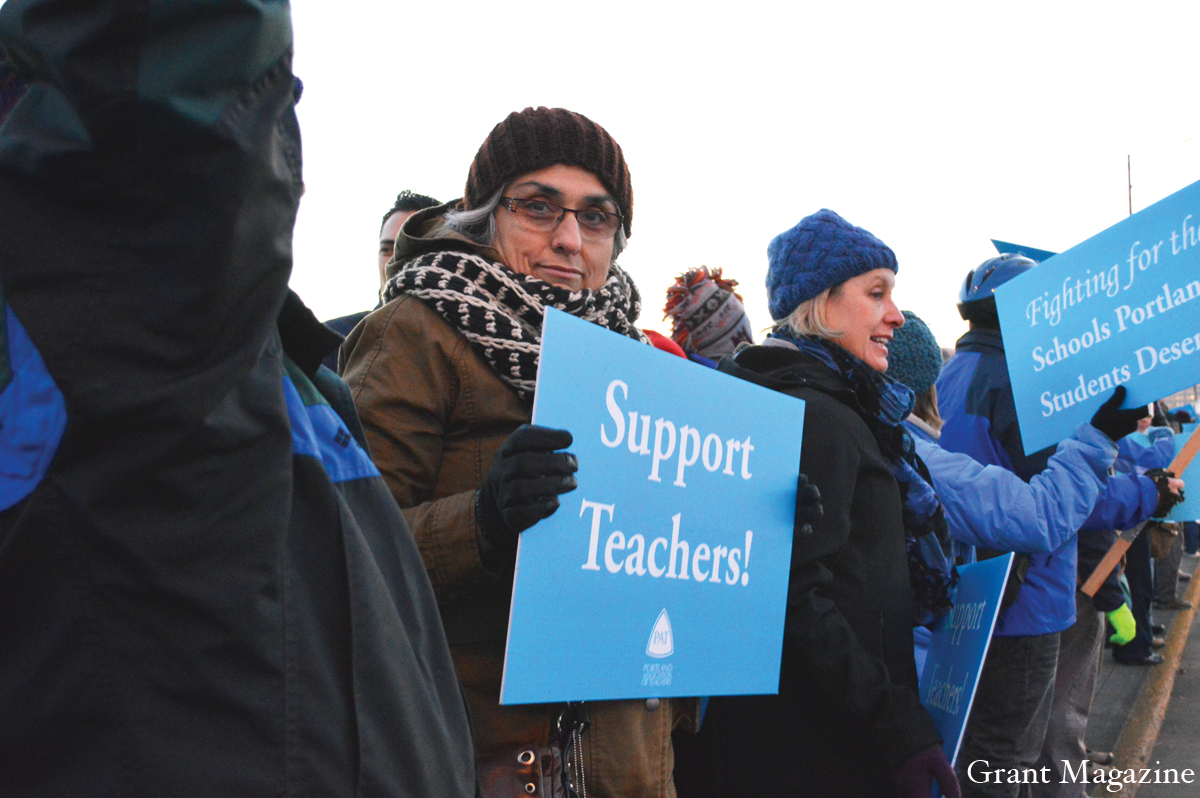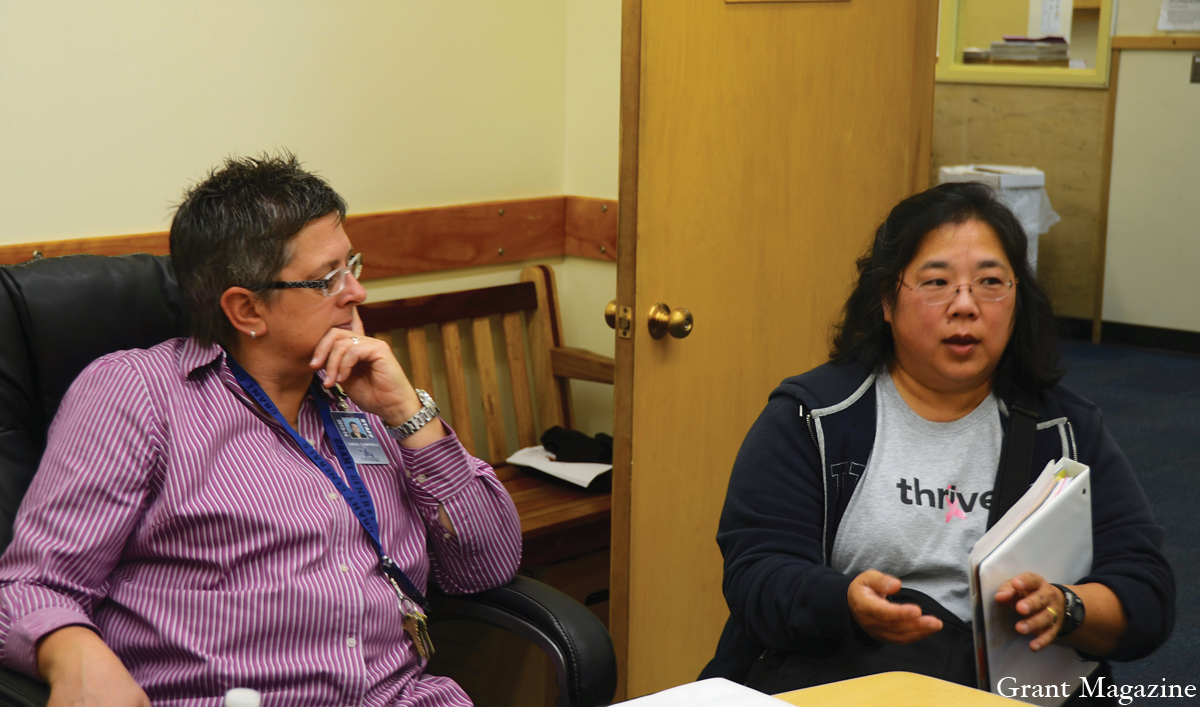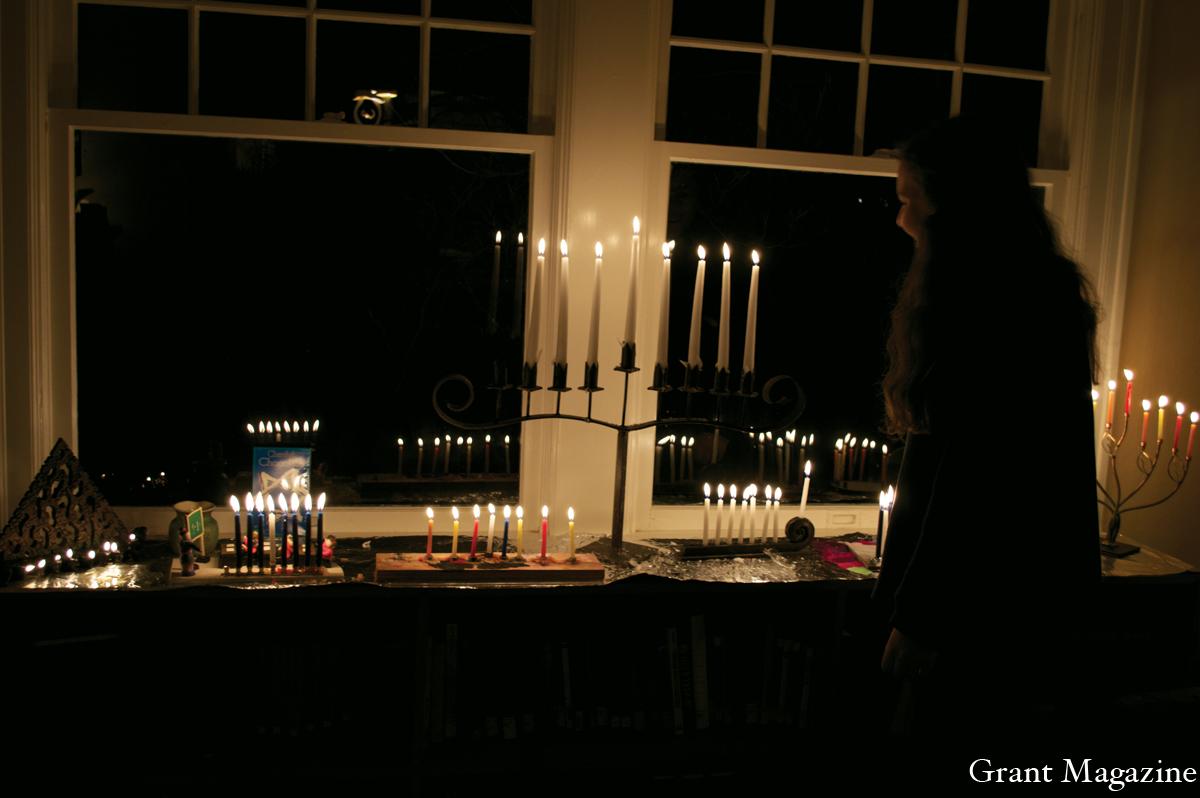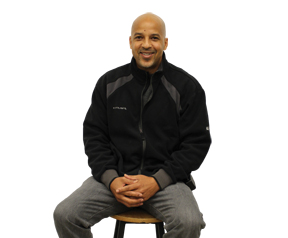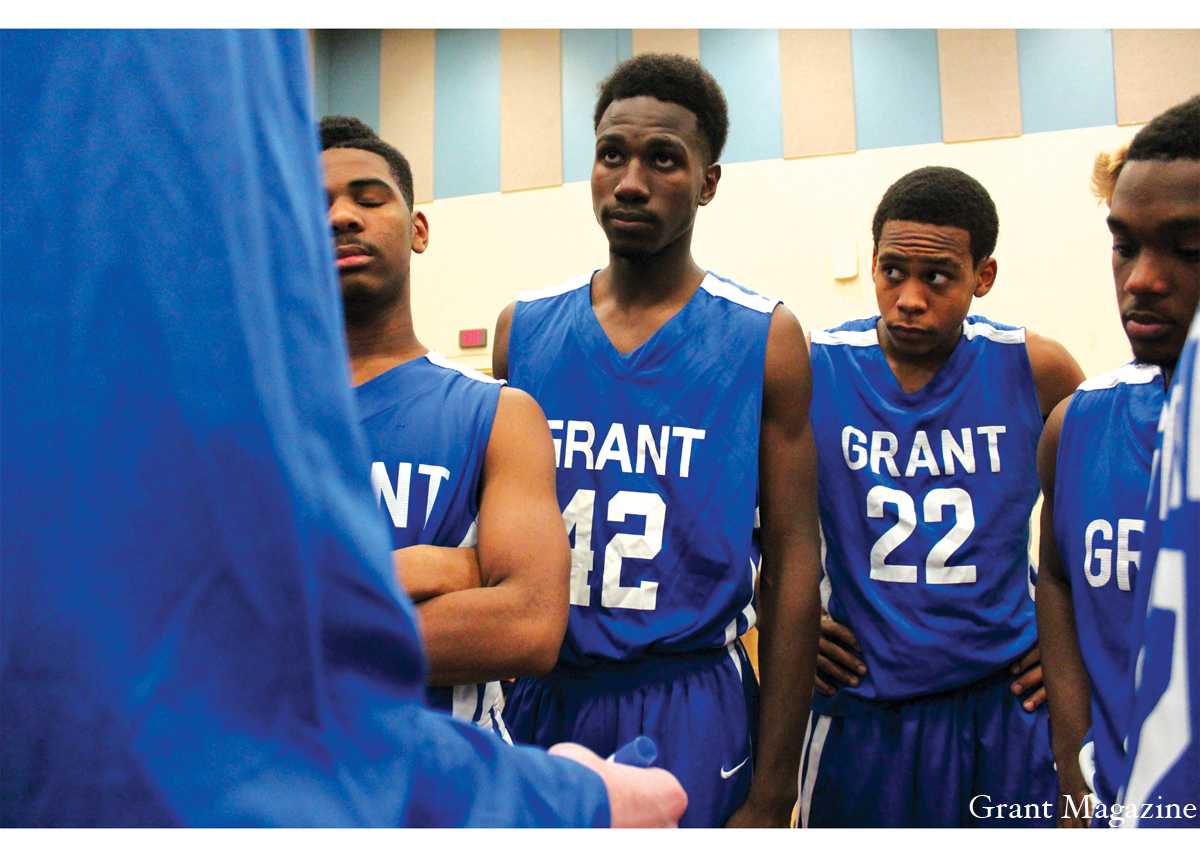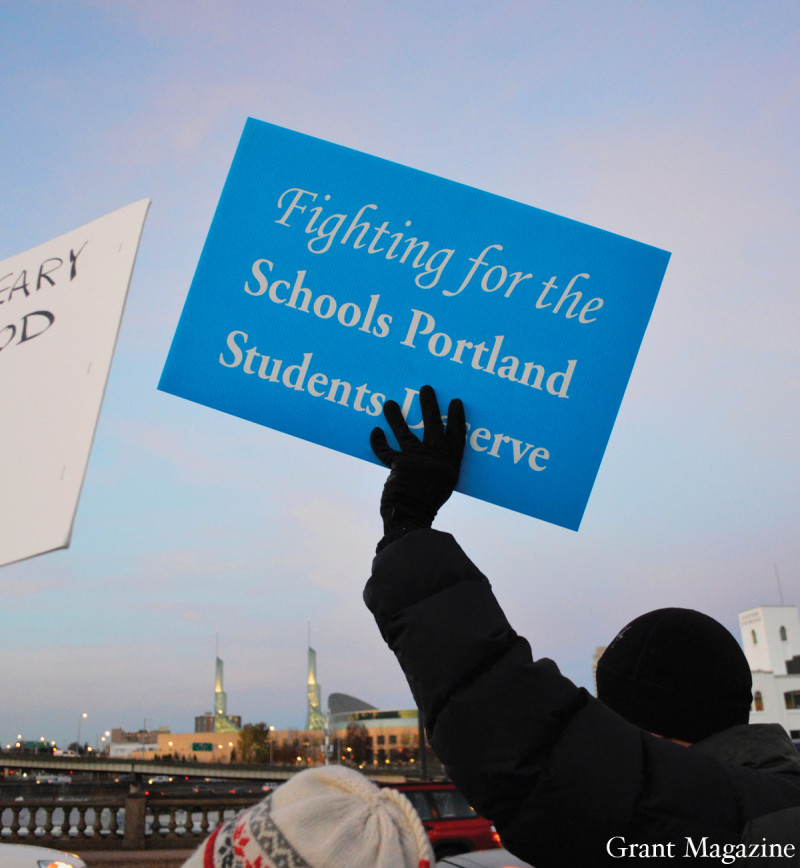
For Grant Japanese teacher Kazuko Page, fourth period is a nightmare. Forty students cram into the classroom, talking and not paying attention to the frazzled teacher. Page is part-time, juggling three different curriculums and more than 90 students. She’s paid for 20 hours a week but estimates she puts in double that amount of time.
“Every year, it gets harder and harder,” Page says. “I feel like we need to set the limit as to how far we can sacrifice the quality of education for our students. I just can’t sacrifice anymore.”
Every few years, Portland Public Schools’ administration proposes a new contract for its teachers. The Portland Association of Teachers (PAT), the powerful teachers’ union, invariably disagrees with the proposal. This sets off an exhaustive process where representatives from both sides meet to negotiate terms – a process that often drags on for over a year before a compromise is finally reached. It’s a familiar fight between the district and the union.
But this time, things are worse. And teachers like Page, who spend a lot of time helping their students, are in the crosshairs. For the first time in more than a decade, there’s a strong possibility that teachers might resort to desperate measures.
“I feel that we’re probably going to end up having a strike,” says Grant math teacher Jim Tucker.
The bargaining this year has moved at a much faster pace than usual – but not because the two sides are making good progress at reaching a compromise.
Instead, teachers’ union members say, the negotiating is closely following the minimum timeline mandated by state labor laws because the district is forcing the process along. “Because they wanted to meet for the minimum amount of time and they’re proposing these major changes to the contract, it’s a very aggressive approach,” says Bill Wilson, Grant science teacher and the union’s bargaining chairperson.
The district disagrees. “Just because the district hasn’t followed those timelines in the past does not mean it’s an aggressive approach,” says Sean Murray, the district’s chief human resources officer and exclusive bargaining agent. “It’s a way of trying to get a contract sooner rather than later.” Murray says the district made it clear from the beginning that they planned to bargain for as little time as possible, wanting to get a contract in place quickly for the benefit of teachers and students.
Specifically, PPS’s team called in a state-appointed mediator as soon as the law allowed, and on Nov. 20 – about two months after mediation sessions began – the district declared an impasse, saying it felt no progress was being made in negotiations.
That means as soon as Dec. 28, the district’s team can implement terms from its final offer to teachers as-is. This action would leave the union with two choices: accept the terms or go on strike.
“If the district decides to impose the contract that they have been presenting to us, my sense is we will strike,” says English teacher and head union representative at Grant, Russell Peterson. “I hope ardently and seriously that that does not happen. It’s kind of the nuclear option. It’s not good for students. It’s not good for teachers. It’s not good for the city of Portland.”
The two sides have been hard at battle for months. Only recently did their rough relationship begin to smooth as they continued to negotiate. Robb Cowie, PPS spokesman, says the teams are reaching agreement on some of the terms.
But the overall outcome is still unclear. The big question is whether the district will continue with its forward momentum and implement terms of its contract, negating the entire point of bargaining and potentially backing the union into a corner.
What this means for students and families is somewhat uncertain, leaving things up in the air. At Grant, students continue to crowd the halls, heading to classes and avoiding the outside chill as school winds down to the winter break. Will the break be longer than expected?
Grant parent Kathy Cooke says she’s trying to stay optimistic. “I have high hopes that the threat will deter (a strike) from happening,” Cooke says. But as a parent, she’s standing on the sidelines. “All you can do as a parent,” she says, “is wish that they didn’t have to be in this fight at all.”
Cooke doesn’t even want to think of what would happen if teachers went on strike. “It would be a nightmare,” she says, adding that the worst part is hurting students.
Regardless, some think a strike is necessary to draw attention to teachers’ needs. Grant senior Madison Moskowitz says a strike would be a way to “stick it to the district” and make it clear that teachers wouldn’t settle for less. “I would definitely support (a strike),” Moskowitz says. However, she adds, “I don’t actually think it’s going to happen,” pointing out tense negotiations of the past where strikes were avoided.
That’s the problem: no one’s sure if it’s going to happen or not. For teachers, every day at work is another step closer to an announcement that could decide their future. They don’t know whether they’ll be back in their classrooms come the new year or manning picket lines.
“We certainly don’t want to strike,” says Mirabai Reimuller, a French and Spanish teacher at Grant. “We’re hopeful that there will be an agreement reached.” But for Reimuller, given the way negotiations have been going, “It’s hard not to feel pessimistic about it. It’s hard not to be discouraged.”
Tucker also gets a bad message from the bargaining. “I think the negotiations have not had a lot of give and take,” Tucker says. A teaching veteran with almost three decades under his belt, Tucker has seen the impact over the years of budget cuts and increased workloads on his students. If things get any worse, he says, “the kids are going to suffer very greatly.” Tucker says he’s reached his limit, which is why he thinks a strike is in the cards.
The reasons for a strike are complex. The steps of the bargaining process are laid out in statutes set by the Employee Relations Board. There are two teams: PAT’s representatives, mostly comprising current PPS teachers, and PPS’s representatives, including principals and district administrators. The bargaining teams may agree upon a proposal at any time, but otherwise must participate for certain amounts of time before they can move on to the next step. Wilson, who has been on the union bargaining team since 2006, says, “In the bargains I have been a part of in the past, it’s never just the minimum.” Not so this year.
Once bargaining begins, the teams must negotiate for a minimum of 150 calendar days before either side can call in a mediator, appointed through the state. This year, the district requested a mediator immediately after the 150 days. At this point, the bargaining that begins as open to the public turns into closed sessions inaccessible to anyone but the bargaining teams. Wilson says this was a surprising move. “There were still topics that we didn’t get to discuss. So it was like them shutting the door on that process,” he says. “Why do they get to dictate that we’re only meeting for the minimum time? If there’s such massive changes in their proposal, which there were, then our students are worth more than the minimum amount of time.”
Murray defends the decision.
“It’s very important for us to get a contract,” he says, “rather than to go through protracted contract negotiations. It becomes disruptive.”
He says the district wasn’t seeing enough movement on key issues, and moving to the next phase of the bargaining process was an attempt to reach a consensus faster. According to Murray, the teams were at different points in the negotiating process. “The district was entering mediation as if it had been bargaining for over 150 days,” he says. “The union entered mediation as if they were starting to negotiate this process.”
Mediation lasts at least 15 days before either side can say they’ve reached an impasse. Wilson remembers mediation lasted almost a year during one bargaining session. This time, two and a half months after requesting mediation, the district moved to the next level of the bargaining process by declaring an impasse, a move that confused and worried union representatives.
“We felt like progress was being made this time,” Wilson says. “We actually met with their team on Monday, and we gave them eight proposals, and at the end of it we talked about meeting later this week – and then on Tuesday they declared impasse.” As Wilson explains, this means that “in their opinion, they weren’t making progress so they’re going to sort of get the clock ticking.
And we’re in a much more serious window now.”
Both sides had to present the mediator with their final offers, including a cost summary, by the end of November. Now the union and the district are in a 30-day cooling off period. During this time the teams can still meet and reach an agreement. In the past, the declaration of impasse has sometimes resulted in a compromise being reached in a matter of weeks. “There’s a lot more pressure created when you declare an impasse,” explains Wilson, “and sometimes that gives reason for parties to try and find a solution. And sometimes it results in a strike.”
If the sides can’t agree on a contract, the cooling-off period ends on Dec. 28. The district may implement terms of its contract then but administrators must declare their intent to do so at least seven days in advance. It also marks the same time the union members can strike, but they must give a 10-day warning.
Portland teachers came close to a strike in 2003. Luckily, last-minute negotiations involving both sides and then-mayor Vera Katz produced a Multnomah County income tax that helped avert a strike, only hours after the union voted to strike.
If the school board votes to impose the terms on teachers, union members will vote on whether or not to strike. That would mean over 2,800 teachers could walk out. In a district where instructional days are already at an all-time low, every day lost to a strike will detract from the students’ education. That’s why this last resort tends to be so effective at getting negotiations moving faster toward a compromise.
The union, members say, is feeling pressured by the district. “The concern, given the strict, narrow timeline the district has been following,” says Peterson, “is that the district would impose their contract as early as they could.
“Don’t push (the union) into a corner because the only option left would be the nuclear option, and we don’t want to do that but we will,” he adds.
The district sees it differently. “Only the Portland Association of Teachers can call for a strike. The Portland School Board cannot force a strike,” district administrators wrote in a piece published on the PPS website last month.
“The district has not walked away from the bargaining table,” says Cowie. “If the district is forced into a position to implement all or part of what’s in the final offer, those conditions would be in place but bargaining would continue until a new contract was resolved.”
The union takes issue with many of the district’s proposed changes, including increases to the length of the work day and putting a numerical cap on the amount the district pays for teachers’ insurance rather than a set percentage.
One of the district’s biggest concerns is the cost summary for the union proposal. “If we were to implement everything that the union’s proposal is offering, it is way out of line with state funding and the district would not be able to afford it,” says Murray. “The cost of our proposal is around $44.6 million. The union’s proposal as we’ve costed it is approximately $240 million.”
A few other issues with the union’s proposal include the lack of added instructional days and an 8.5 percent cost-of-living increase. “The association talks about the schools that students deserve and yet on the other hand they’re talking about not adding any instructional time for students,” says Cowie, pointing out that the district is proposing to add three school days. “The more that we’re paying in cost-of-living increases, the less resources we have to hire more teachers and reduce class sizes, so we can’t have it both ways. We’ve got to find the balance between what are fair and competitive and sustainable pay and benefit increases for teachers and ones that allow us to hire more teachers, offer more programs for students, and pay for a longer school year.”
Some wonder, though, if the school board is able to make an informed decision if it hasn’t been involved in direct bargaining discussions with the union. “When we try to explain what our needs are, how much of that gets directly back to the decision makers?” Wilson asks. “And how much do those decision makers, the board members and Superintendent (Carole) Smith, actually understand what our needs are in terms of our proposal?”
The two sides continue to argue and point fingers. The district points out that the union hired a political consultant and brings attention to PAT’s misinformation campaign. The union highlights the district’s unclear priorities and emphasizes PPS’ system of barriers between the decision makers and the negotiations.
Meanwhile, teachers are uneasy. As the negotiations hurtle along a track towards a strike, everyone is prepared for the worst.
“I am disappointed it’s come to this,” says Grant history and philosophy teacher, Don Gavitte. “I don’t want to strike. No one wants to strike.”
It’s not just the teachers. Students are taking notice too.
Senior Caleb Gumanow feels teachers aren’t appreciated enough for the amount of work they put in, and the district’s proposal is an unacceptable “ultimatum.” Gumanow, a member of the Portland Student Union, says the district’s offer will have “harsh consequences” for students and teachers alike. “I feel strongly that things need to go more in favor of the teachers union,” he says. And if they don’t? Gumanow says students need to support their teachers if a strike occurs. After all, “we’re one big school and the teachers do a lot for us,” he says. Gumanow adds that though a “strike would cut into our education, it’s kind of necessary.”
Student body president and senior Madeline Williams agrees. Despite the consequences of going on strike – namely losing school days – “in the long run it will have enough of an impact to make up for it,” she says. “It scares me that something has to happen like that in order to get a message across.” ♦
See what happened at Grant in February as tension continued.

